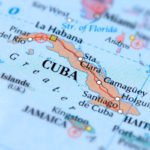While the Caribbean as a whole is a beautiful, wonderful place, Cuba is one of the jewels in the Caribbean’s crown.

It is a gorgeous tropical paradise that rivals some of the most beautiful places on earth.
Its landscape is filled with all manner of tropical terrain and mountainous environments that have long fascinated foreigners and foreign nations alike.
This proud land is like nowhere else on earth, and today we are going to give you the rundown of Cuba’s geography and environment with all its trappings.
If you have a distinct love of the outdoors, then a trip to Cuba might be the place for you.
Geography Of Cuba
Cuba is the largest island in the Caribbean, the 17th largest island in the world, and the 8th largest island nation in the world.
With it being ever so slightly larger than the number 9 spot, Iceland, but almost 2 times as small as the 7th spot, the United Kingdom.
In total, the nation of Cuba is around 110,860 square kilometers or about 42,800 square miles, which incorporates the island of Cuba, as well as a lot of smaller islands and archipelagos around it.
Like the Isla de la Juventud, which is the second-largest Cuban island and the 7th largest island in the West Indies.
The topography and terrain of Cuba is quite diverse, but the majority of it lends itself to flat plateaus or plains that turn into rolling, gentle hills.
However, there are quite a few mountainous areas along the coastline, with the interior of the island remaining flat.
The main mountain ranges are in the south-west, south-east, central areas, and north-west of the country, but they are largely contained to the south.
The main mountain range of Cuba is in the south-western region, and the range is called Sierra Maestra.
The Sierra Maestra mountain range surrounds the second-largest city of Santiago de Cuba and has the tallest mountain on the island, Pico Turquino, which stands at around 1,999 meters tall.
The other mountain ranges have fairly tall mountains, but nothing with this kind of height or size.
The island of Cuba, despite being fairly large, has very few sources of fresh water to draw from, including fresh water springs or rivers and this presents a little bit of a challenge for the Cuban people.
The largest lake on the island of Cuba is Laguna de Leche, which is located in the central Ciego de Ávila province, and there is also a man-made reservoir called Zaza Reservoir in the city of Sancti Spiritus, a little bit north of the Ciego de Ávila.
There are also a few rivers, but the majority of big rivers run through the mountains of the south and basically through only 3 or 4 provinces.
The longest river in Cuba is the Cauto River, which also happens to be the longest river in the Caribbean, and though it is over 230 miles long, it flows through only the 3 most southern provinces.
There may not be many rivers or natural water sources in Cuba, but each one is a lifeline, and they are used to great effect by the people of the country for their benefit.
This is aided by a persistent rainy season as well, and a generally humid climate.
Climate Of Cuba

All of Cuba’s national territory is situated south of the Tropic of Cancer. The Tropic of Cancer is a longitudinal line that crosses the entire globe, with its counterpart being the Tropic of Capricorn further south of it.
Anywhere in between these two lines is considered to be in the tropical part of the world, due to their proximity to the equator.
This makes the Cuban climate a tropical one that rarely changes in temperature and is only slightly affected by the constant north-eastern trade winds that blow across Cuba all year long.
As well as these trade winds, the Caribbean current in the ocean always makes its way around Cuba.
This current flows throughout the Caribbean and brings warm water from the equator to the area, keeping the water at a reasonable and pleasant temperature around the island.
Due to its global position and the weather’s influence on the area, the climate of Cuba could be compared to Hainan or Taiwan in temperature, with these two places being slightly colder than Cuba.
Throughout the year, Cuba maintains a temperature of 18 degrees Celsius at its lowest and 32 degrees Celsius being its usual highest.
January is the coldest month and has an average temperature of 23 degrees Celsius, with July being the warmest month and having an average temperature of 27 degrees.
Cuba tends to only have two seasons, rather than the four seasons of more temperate climates.
These are the dry season from November to April, with less rain, and the wet season from May to October, with more rain.
The wet season is also known as Hurricane season, which Cuba is prone to experiencing a lot thanks to its global position.
Biodiversity Of Cuba
Cuba is one of the world’s biodiversity hotspots, with many of the species that live on the island being found nowhere else on the earth.
Sometimes, people may refer to Cuba derogatorily as an ‘Accidental Eden’, but this view is not held by many and actually actively ignores the efforts of the Cuban people and government to protect its environment.
In fact, a study put forth by the WWF basically named Cuba as the only country in the world to meet the conditions of sustainable development that they suggested, which really says something to their commitment to the environment.
There are currently 6,500 species of vascular plants, 154 species of reptiles, 67 species of amphibians, and 27 species of birds found on Cuba and nowhere else on earth, which makes it enormously important to conservation.
Cuba has currently six ecoregions within its borders where these animals survive: Cuban moist forests, Cuban dry forests, Cuban pine forests, Cuban wetlands or swampland, Cuban cacti shrub, and Greater Antilles mangrove swamps.
Although these ecoregions are at risk and their integrity is not great, the efforts of the Cuban people have kept them from degrading further and improved them in some areas.
Biodiversity is in fact one of the many reasons that people go to Cuba.
The country is split between cities on the coast, towns in the center, and vast areas of untouched wilderness with small villages dotted around the countryside, making it an ideal paradise for those that want to explore.
Considering it has six completely different ecoregions to go to and extremely friendly locals willing to aid people, this is perfect for even the wariest wilderness survivalist.
Conclusion
The island of Cuba is a tropical island nation that sits in the middle of the Caribbean.
It is known for its beautiful climate that makes people want to sit away the day and the absolutely outstanding natural beauty that lets you explore unseen places and survey the entire beautiful island itself.
If you were thinking about going to Cuba, but were worried about the environment, there is no need to be as it is definitely worth the trip there.
- What Is The Largest Island In Cuba? - September 19, 2022
- Havana – Why Is It Cuba’s Most Exciting City? - September 19, 2022
- Cheapest Time To Visit Cuba (Ultimate Guide) - September 19, 2022








